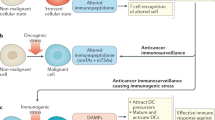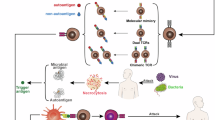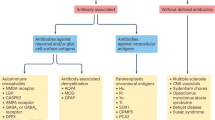Abstract
AN important characteristic of the immune system is the ability to discriminate between antigens expressed on normal tissues within the individual and the many foreign antigens expressed on normal tissues of other species (xenoantigens) and even on normal tissues of members of the same species (alloantigens). Thus, although the immune system readily destroys inoculated xenogeneic and allogeneic tissue, autoimmune damage to normal, autologous tissue is rare. The rejection of inoculated foreign tissue is thought to reflect an immune surveillance mechanism by which an individual could detect and eliminate his own aberrant cells expressing abnormal surface antigens1. This mechanism may be important in restricting the development of many nascent tumours1–3. Little is known, however, concerning either the mechanism by which the immune system destroys nascent tumours or the mechanism preventing the immune system from inflicting autoimmune disease. The finding of near normal tumour incidence in congenitally athymic (nude) mice has suggested that immune surveillance may not involve the activity of thymus-dependent immunity but rather be a function of humoral immunity4. In this respect it is interesting that sera of both normal and nude mice contain antibodies reactive with a wide variety of tumour cells5,6. There is no evidence, however, that these antibodies function in the destruction of nascent tumours or that they are necessarily directed against tumour specific rather than normal tissue associated antigens. It has been demonstrated that naturally occurring antibodies (NOA) reactive with the neural tumour cell line NB1 can be specifically absorbed by syngeneic normal brain tissue6. We demonstrate further the autoantibody nature of certain NOA by documenting the occurrence in normal mouse sera of IgM antibodies reactive with autologous thymus cells.
This is a preview of subscription content, access via your institution
Access options
Subscribe to this journal
Receive 51 print issues and online access
$199.00 per year
only $3.90 per issue
Buy this article
- Purchase on SpringerLink
- Instant access to full article PDF
Prices may be subject to local taxes which are calculated during checkout
Similar content being viewed by others
References
Burnet, F. M., Immunological Surveillance (Pergamon, New York, 1970).
Smith, R. T., and Landy, M., Immune Surveillance (Academic, New York, 1970).
Martin, W. J., Cell. Immun., 15, 1–10 (1975).
Rygaard, J., and Povlsen, C. O., Transplantation, 17, 135–136 (1974).
Martin, W. J., and Martin, S. E., Nature, 249, 564–565 (1974).
Martin, S. E., and Martin, W. J., Int. J. Cancer (in the press).
Martin, S. E., and Martin, W. J., Proc. natn. Acad. Sci. U.S.A., 71, 1036–1040 (1975).
Schlesinger, M., Nature, 207, 429–430 (1965).
Shirai, T., and Mellors, R. C., Clin. exp. Immun., 12, 133–152 (1972).
Boyse, E. A., Bressler, E., Iritani, C. A., and Lardis, M., Transplantation, 9, 339–341 (1970).
Raff, M. C., Israel J. med. Sci., 7, 724–727 (1971).
Author information
Authors and Affiliations
Rights and permissions
About this article
Cite this article
MARTIN, W., MARTIN, S. Thymus reactive IgM autoantibodies in normal mouse sera. Nature 254, 716–718 (1975). https://doi.org/10.1038/254716a0
Received:
Revised:
Issue date:
DOI: https://doi.org/10.1038/254716a0
This article is cited by
-
Inherent specificities in natural antibodies: a key to immune defense against pathogen invasion
Springer Seminars in Immunopathology (2005)
-
Autoantibodies in systemic lupus erythematosus and normal subjects
Clinical Rheumatology (1986)
-
Autoantibody against TL.6. presence in a widely-distributed anti-Ia serum
Immunogenetics (1982)



